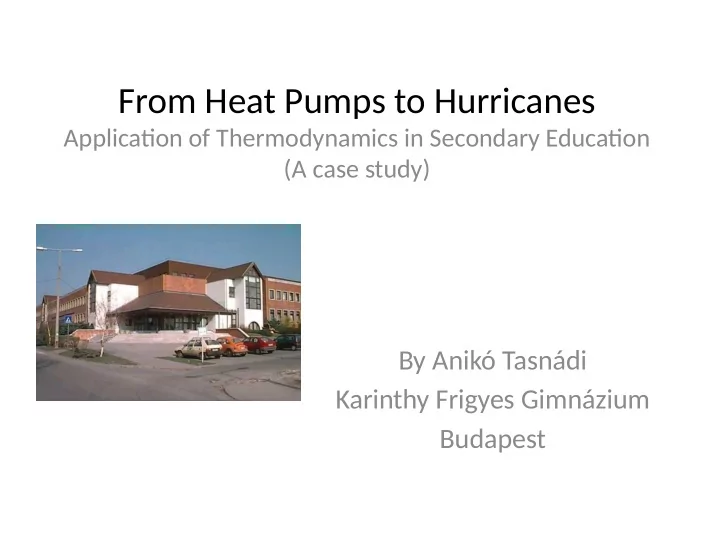

From Heat Pumps to Hurricanes Applicatjon of Thermodynamics in Secondary Educatjon (A case study) By Anikó Tasnádi Karinthy Frigyes Gimnázium Budapest
Outline • Ratjonales • Task given to the students and background • Issues to discuss – Engines – Heat pumps – Environmental consideratjons – Tropical cyclones • Assessment
Ratjonales Physics behind Groupwork and Technical devices; presentation Natural phenomena (8 extra lessons) Environmental issues
Task and Background • Group: Research different – 17-18 year old secondary devices which are school students (19 students) – 2-year preparatory course for operated either as a the University (4 lessons per -heat engine or a week) -heat pump. • Previously covered topics: – Gas laws – Kinetic gas model – Processes (isothermal, isochoric, isobaric, adiabatic and cyclic processes) – First and second laws of thermodynamics – Otto and Diesel engines
Refrigerators Heat pumps Cooling of computers Chosen Devices Wankel engine Gas turbine Stjrling engine
Effjciency of car engines Ideal Diesel cycle Ideal Otuo cycle η =1- ( V 1 ) κ − 1 V 2 ϕ− 1 ⋅ ( V 1 ) κ− 1 κ − 1 V 2 κ⋅ϕ η= 1 − 1 ϕ= V 3 Some Discussion points: V 2 ● Octane number ● Cyclic processes ● Fuel ● Internal combustion engine ● Efficiency ● Spark plug ● Compression ratio
Environmental issues • Depletjon of oil • Banning of lead • Exhaust is harmful – Carcinogen molecules – Partjculate matuer
Wankel and Stjrling engines • Wankel engine (rotary • Stjrling engine – Any heat source; engine) – Great effjciency – High effjciency – Frequent services – Big, slow to ignite – Harmful exhaust gases
Heat Pumps Discussion points: • Reversed heat engines • Transfer thermal energy from cold c C to warm place Q c Q c Q c Q C • External work is needed • Used for cooling or heatjng • The greater the temperature Coeffjcient of performance: difgerence the smaller the COP (COP)
Compression and Absorptjon Type Refrigerators V a p o u r C o m p r e s s i o n C y c l e Some discussion points: ● Latent heat of phase change - evaporation: heat is absorbed - condensation: heat is released ● Compressor is operated with electric current ● The absorption refrigerator is quieter, has smaller COP than the compression type. ● The absorbant can be heated with any heat source in case of absorption refrigerators (waste heat, solar power)
Some HVAC devices ( Heatjng, ventjlatjng and air conditjononing) Air-sourced Water-sourced Geothermal heat pumps heat pump heat pump The cheapest, Shallow, Most efficient, Deep vertical horizontal heat Can be used anywhere, high and constant system , Its COP depends on the exchangers at a temperature ground depth: 60-100 m outdoor temperature, depth of 1-2 m water, COP: 4-5 COP:3.5-4.7 Big area is needed two wells. COP: 4-5 COP: 5-7
Environmental issues ● Question of refrigerants - Freon ruins the Ozone layer -Tetrafluoroethane (H 2 CFCF 3 ) is a strong greenhouse gas -Ammonia is toxic ● The temperature of both J. C. Mckay: reservoirs change If in a typical British suburb everyone ● Geo tariff used ground-sourced heat pump, then the ground would freeze in the winter. A cheaper heating with the energy of the ground. With the new heat-pump system and the GEO tariff you can heat your home economically. An advertisement in Hungary
Tropical Cyclons Hurricane, Typhoon, Kamikaze (evil or divine wind)
Formatjon of Hurricanes Necessary conditions of formation: ● Warm sea surface water (27 O C) ● Instability of air ● Strong ascent (deep convection) of air (causing a low pressure area) ● Strong vorticity (rotation) ● Weak wind sheer Some discussion points: ● Coriolis force ● Formation ● Cyclic process
A nearly Carnot cycle A Q 1 B T ab ≈300K D T c ≈200K Q 2 C Effjciency: approximately 1/3
Assessment 1. Percentage values of correct answers for the questjons True-or-false 120% questjons based on 100% the covered topics 80% 60% (8 groups of questjons; each containing 3 or 4 40% questjons) 20% 0% 1 2 3 4 5 6 7 8
Some of the questjons 2.c) In Diesel engines the pure air is compressed. (True) 73% 5.d) If the same heat pump can be operated in order to cool down and to heat up the room, then its COP is greater when it is used for cooling. (False) 87% 5.c) In the gas-compression type refrigerators the condensing refrigerant absorbs heat from the environment. (False) 80% 6.d) In a hurricane the ascending wet air condenses and heats up the ambient air. (True) 33%
Assessment 2 The following questjons were evaluated from 1-5 1. Did you fjnd useful to prepare for your oral presentatjon? 4.46 2. Did you fjnd the lectures useful? 4.15 3. Did you fjnd the lectures interestjng? 4.31 4. Did you learn from the lectures? 3.69 5. Would you like to learn this way in the future? 3.42
Thank you very much Thank you very much for your attention. for your attention.
Recommend
More recommend